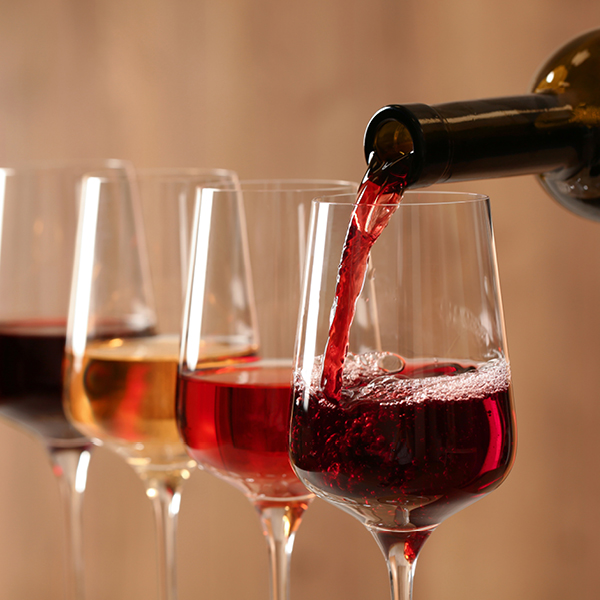Wine Terminology Every Party Host Needs to Know
Hosting an event, but not sure how to impress your guests with the correct wine terminology? No fear. We are here to share tips on how to bluff your way around the wine list.
We’ll start by setting the stage with perspectives from New York Times wine critic Eric Asimov. He’s known for his laments on how people think they need to know something about wine to enjoy it. He covered the topic in his print column, on radio, online and even wrote a book “How to Love Wine” in an attempt to expose the great ‘wine expert’ ruse. He makes fun of wine snobbery with the line “I’m getting floral bouquets, playful summers of rosy-cheeked children and classic tones of Albanian leather, aren’t you?”
Not to be confused with actual expert sommeliers, these ‘wine experts’ he mocks have a natural habitat of intimidating others and “depriving them of an exquisite experience.”
He says that if other pleasurable tasks were treated with such fearful reverence, then everything from reading a book to selecting a hotel room would be fraught with self-doubt and stress. This is especially bad for our little island where eating out and hosting your own parties is essential to making friends and staying sane. That’s why we’ve put together this list to get you up to speed but also keep you humble.
New vs Old World Wine
These terms reference where the wine is made, how it is made and how it tastes. Old World wines tend to be made in places where old paintings of royalty come from such as France, Italy, Spain and Germany, and are notable for being fuller bodied, heavier and more complex in flavor. They are also referred to as “food wines” as they taste better when paired with a meal.
New World wines tend to be made in the places TV shows about surfing come from such as the U.S., South America and Australia. They tend to be made in warmer climates where the fruit can get riper and so tend to be very fruity, fresh and very drinkable all by themselves.
Light vs Full Bodied (For red wine only)
Dark purple-coloured wines are full-bodied while lightly pigmented wines are light-bodied. To work out which you have, tilt your wine glass over your menu or watch – if you can read it through the wine it is light-bodied.
Light-bodied wines are always described with feminine terms so use phrase like “elegant colour,” “lovely red fruit” or “sensual, seductive and silky” and note the presence of red fruits like raspberry, strawberry or cherry (any or all will do).
If you find yourself with a full-bodied red then go uber-machismo with phrases like “dense and strong colour” or “intense dark fruits” and switch your fruits to blackberries, black currants and/or plums.
After swallowing, if your mouth feels a little dry or rough then announce “ooh, firm tannins,” guaranteed to draw agreeable hums and head nods.
Added Grape Variety
Although there are thousands of varieties of grape being grown today, there are 5 main types to remember for your grape varietals:
- Cabernet Sauvignon
- Merlot
- Pinot Noir
- Chardonnay
- Sauvignon Blanc
If the art of bluffing is not your thing then you could always just say what you really think. Asimov points out that one of the biggest problems with wine is people say what they think they’re supposed to say as opposed to what they really think about wine. Wine is a drink, and if you like it or not, your opinion is just as correct as even the most disciplined sommelier.
But, if you are up for a deeper challenge, here are more terms to get familiar with.
- Body
Describes the weight and fullness of a wine on the palate, ranging from light-bodied to full-bodied.
- Bouquet
The combination of scents derived from the aging process, providing a complex aroma in mature wines.
- Vintage
Denotes the year the grapes were harvested, influencing the characteristics of the wine.
- Appellation
Indicates the wine’s origin, specifying the region where the grapes were grown.
- Oakiness
Describes flavors and aromas imparted by oak barrels during the aging process.
- Crisp
Describes a wine with refreshing acidity, often associated with white wines.
- Finish
Refers to the taste lingering on the palate after swallowing, indicating a wine’s length and complexity.
- Sediment
Solid particles that settle in the bottom of a wine bottle over time, especially in older wines.
- Aeration
Exposing wine to air, either through decanting or swirling, to enhance its flavors and aromas.
- Legs
The streaks that form on the inside of a wine glass after swirling, indicating alcohol and glycerol content.
- Fermentation
The process where yeast converts sugars into alcohol and carbon dioxide.
- Oxidation
Exposure of wine to air, affecting its flavor and aroma, often undesirable in certain styles.
- Balance
A harmonious integration of acidity, tannins, alcohol, and fruit flavors in a wine.
- Reserve
Denotes a higher quality or specially aged wine selected by the winemaker.
- Complexity
The presence of various flavors and aromas that evolve as the wine is enjoyed.
- Minerality
Describes non-fruity and non-herbaceous flavors, often associated with the soil where the grapes were grown.
When you are feeling bold enough to show off your new skills, head over to Massive Equipment glass rentals to get your party started.
